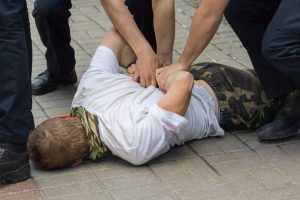 Since at least 2012, what is commonly referred to as a chokehold has been banned by the Chicago Police Department, although prior to that, the maneuver was once taught in the Chicago Police Academy. A variety of other holding techniques are authorized by the CPD for the purpose of restraining subjects which include wristlocks and applying pressure to skin and pain sensors that cover joints and bones. Police dogs, batons, Tasers, and pepper spray are also authorized depending upon the circumstances. But Chicago Police policy directs officers that once they have gained control of the offender, that are to avoid kneeling, sitting or standing on the person’s chest so that a suspect’s ability to breathe properly is not restricted. They are also instructed to avoid placing the offender in a face down position for largely the same reasons.
Since at least 2012, what is commonly referred to as a chokehold has been banned by the Chicago Police Department, although prior to that, the maneuver was once taught in the Chicago Police Academy. A variety of other holding techniques are authorized by the CPD for the purpose of restraining subjects which include wristlocks and applying pressure to skin and pain sensors that cover joints and bones. Police dogs, batons, Tasers, and pepper spray are also authorized depending upon the circumstances. But Chicago Police policy directs officers that once they have gained control of the offender, that are to avoid kneeling, sitting or standing on the person’s chest so that a suspect’s ability to breathe properly is not restricted. They are also instructed to avoid placing the offender in a face down position for largely the same reasons.
George Floyd and Eric Garner Police Chokehold Deaths
The use of chokeholds has been in the news recently of course due to the death of George Floyd while in custody of the Minneapolis Police Department. In a videotaped encounter, a police officer, who has now been charged with third-degree murder, is seen kneeling on the man’s neck while he begs the police to stop and indicates that he cannot breathe. Bystanders videotaped the incident while they implored the police to stop.
That this death occurred is even more shocking in light of the fact that chokeholds were placed squarely in the national spotlight in 2014 by the Black Lives Matter movement after the senseless death of Eric Garner at the hands of a New York Police Department officer. During that attempted arrest, Mr. Garner was placed in a chokehold while being restrained by an NYPD officer on suspicion of selling loose cigarettes. The officer claimed that he had placed the offender in a “seatbelt maneuver”, rather a chokehold. He was never even indicted and never faced trial, sparking public outrage and demonstrations just as are now occurring in cities across the country including Chicago due to the police death of George Floyd. Since that time, the NYPD spent over $35,000,000 to help retrain police in the avoidance of strangleholds and chokeholds. But still, in just the last five years, that department alone had over 800 complaints filed alleging the use of these banned holds.
Types of Police Chokeholds
When used in law enforcement, the technical term is lateral vascular neck restraint. Its goal is to force an uncooperative suspect to comply without causing any permanent injury or death. There are two basic types of holds:
- Blood Choke – Of the two types of choke holds, the blood choke is considered to be the safer of the two. The hold involves blocking/compressing both the left and the right carotid arteries/jugular veins at the same time. If properly applied, this restricts blood flow and therefore oxygen to the brain, resulting in almost immediate compliance and a halt to resisting on the part of the suspect. Once released, the blood and oxygen flow again to the brain without any permanent injury. But if this maneuver is held for longer than a few seconds, the offender may fail to regain consciousness and suffer permanent brain damage or death due to hypoxia. A blood choke is also referred to as a strangle hold, rear naked choke, bilateral carotid compression and sleeper hold.
- Air Choke – In contrast, an air choke occurs when the police officer puts pressure on the suspect’s throat/neck area, rather than the arteries. Although this move is intended as a method to obtain compliance with police orders, if done for a sustained period of time, the restriction of oxygenated blood to the brain can easily result in serious brain injury or death. Even if that doesn’t happen, permanent injury to the alleged offender’s larynx or trachea may result. An air choke is also referred to as a true choke, tracheal choke, push choke or wind choke and is typically a prohibited maneuver in police departments, including Chicago's. As a matter of fact, the US Supreme Court held in Tennessee v. Garner that an officer must have probable cause that an imminent threat of death or great bodily harm exists to justify using this move.
Experienced Police Brutality Attorneys
Since 1990, the legal team at Mitchell S. Sexner & Associates LLC has helped families harmed due to excessive police force and police brutality recover proper compensation for their injuries. Contact our criminal attorneys any time of day at (312) 644-0444 for free information about how we can be of immediate assistance.
